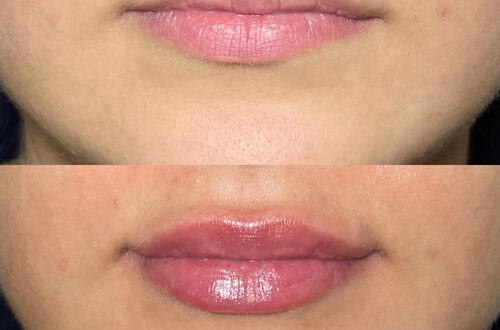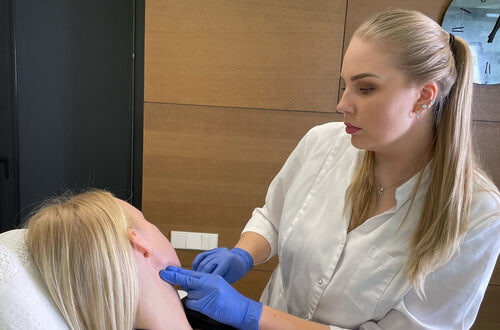Schedule a Dermal Filler Appointment with Dr. Laura Geige at It’s Me and You Clinic
What is Tear Trough Filler?
Understanding the Under-Eye Area
Tear trough fillers are a cosmetic treatment designed to address the hollowness and shadows commonly seen beneath the eyes, known as tear troughs. These hollows can appear due to factors like aging (loss of fat and collagen), genetics, allergies, or simply the natural course of life.
The under-eye area is particularly delicate. It’s thin-skinned with minimal muscle and subcutaneous fat compared to other areas of the face. As we age, these tissues naturally deplete, leading to a visible hollowing and prominence of blood vessels beneath the surface. This can create dark circles, making the eyes look tired or aged.
Tear trough fillers aim to restore volume and smooth out these depressions. Hyaluronic acid-based fillers are most commonly used due to their ability to attract and hold water, plumping the area and minimizing shadows.
The placement of filler is crucial for natural-looking results. A skilled injector will carefully assess facial structure and tailor the amount and placement of filler to create a subtle enhancement, restoring volume without looking artificial or overfilled.
The Role of Hyaluronic Acid Fillers
Tear trough filler is a cosmetic procedure used to address under-eye hollows or “tear troughs.” These depressions can make individuals appear tired, aged, or gaunt.
Consult Dr. Laura Geige for Your Dermal Fillers Now
Hyaluronic acid (HA) fillers are the most common type of filler used in tear trough treatments. HA is a naturally occurring substance in the body that helps retain moisture and provide volume.
During the procedure, a qualified cosmetic injector carefully injects HA filler into the tear trough area. This adds volume to the sunken area, smoothing out the appearance of hollows and restoring a more youthful contour to the under-eye region.
The benefits of tear trough fillers include:
- Reduced appearance of dark circles
- Smoother, more contoured under-eye area
- Enhanced facial symmetry
- A more refreshed and youthful appearance
Hyaluronic acid fillers are generally safe and well-tolerated. However, like any cosmetic procedure, there are potential risks and side effects, such as bruising, swelling, redness, and lumps.
It is essential to consult with a qualified and experienced cosmetic injector to determine if tear trough fillers are right for you and to ensure safe and effective treatment.

How Is Tear Trough Filler Done?

Consultation and Assessment
Tear trough fillers are a popular cosmetic procedure used to address under-eye hollows, also known as tear troughs.
During a consultation for tear trough filler, a qualified aesthetic practitioner will assess your individual needs and goals.
Here’s what typically happens:
- Medical History Review: The practitioner will review your medical history, including any allergies, medications you’re taking, and previous cosmetic procedures.
- Assessment of Tear Trough Area: They will carefully examine the under-eye area, evaluating the depth and location of the hollows, as well as the skin’s texture and elasticity.
- Discussion of Expectations and Risks: The practitioner will discuss your desired outcomes and realistic expectations for tear trough filler. They will also explain potential risks and side effects, such as bruising, swelling, and infection.
- Treatment Plan Development: Based on the assessment, the practitioner will recommend a personalized treatment plan, including the type of dermal filler, dosage, and injection technique.
Before the procedure, you may be asked to avoid certain medications or supplements that can increase bleeding or bruising.
During the actual treatment:
- Numbing Cream Application: A topical numbing cream is applied to the under-eye area to minimize discomfort.
- Filler Injection: The chosen dermal filler is carefully injected into the tear trough using fine needles. The practitioner will inject strategically to restore volume and smooth out the hollows.
- Massage and Aftercare Instructions: Gentle massage may be performed to distribute the filler evenly. You will receive detailed aftercare instructions, including tips for minimizing swelling and bruising.
Most people can resume normal activities immediately after the treatment, although it’s best to avoid strenuous exercise or rubbing the area for a few days.
Procedure Details
Tear trough filler treatment is a non-surgical procedure used to address the under-eye hollows, commonly known as tear troughs.
Procedure Details:**
The process typically involves injecting dermal fillers into the tear trough area using a fine needle. These fillers are made from hyaluronic acid, a natural substance found in the body that helps to add volume and hydration.
**Preparation:** Before the procedure, the treatment area will be cleansed and numbed with a topical anesthetic cream.
Injection Technique:**
The filler is injected into the tear trough using a precise technique to lift and fill the hollowness. Multiple injections are often given in small amounts to create a natural-looking result.
Reserve Your Dermal Filler Consultation with Dr. Laura Geige
**Duration:** The procedure itself usually takes about 30 minutes.
**Aftercare:**
Following the treatment, there may be some mild swelling and bruising, which typically subsides within a few days. It is important to avoid strenuous activity and direct sunlight for the first few days after the procedure.
**Results:** The results of tear trough filler are typically immediate and can last anywhere from six months to two years, depending on the individual’s metabolism and lifestyle.
Note:** It is crucial to consult with a qualified and experienced medical professional for tear trough filler treatment. They will assess your individual needs and determine if you are a suitable candidate for this procedure.
Aftercare Instructions
Tear trough filler injections are a non-surgical cosmetic procedure designed to address under-eye hollows and dark circles.
Here’s a step-by-step explanation of the process:
-
Consultation: Your journey begins with a consultation with a qualified injector, usually a dermatologist, plastic surgeon, or nurse practitioner. They will assess your under-eye area, discuss your goals, and determine if tear trough filler is right for you.
-
Preparation: Before the procedure, your injector will clean and numb the treatment area with a topical anesthetic cream to minimize discomfort.
-
Injection Technique: Using a very fine needle or cannula, the filler is carefully injected into the tear trough area. The exact injection points and technique vary depending on individual anatomy and desired outcomes.
-
Filler Type: Hyaluronic acid (HA) fillers are most commonly used for tear trough enhancement because they are naturally occurring substances in the body, provide a smooth lift, and can be reversed if necessary.
-
Result Adjustment: After injecting the filler, the injector will gently massage the area to ensure even distribution and achieve the desired contour. Additional adjustments may be made as needed.
Aftercare is crucial for optimal results and healing.
-
Avoid touching or rubbing your treated area for at least 24 hours to prevent bruising or swelling.
-
Keep your head elevated while sleeping in the first few nights to reduce puffiness.
-
Apply a cold compress to any swelling for 10-15 minutes at a time, several times a day.
-
Avoid strenuous activity, excessive sun exposure, and hot saunas or steam rooms for a few days.
-
Follow your injector’s specific instructions regarding makeup application and skincare routines.
You should see the initial results of your tear trough filler immediately, but it may take several days to fully settle. Results typically last for 6-18 months, depending on the type of filler used and individual factors.
Considerations Before Getting Tear Trough Filler
Potential Risks and Side Effects
Tear trough filler is a cosmetic procedure that involves injecting hyaluronic acid (HA) gel into the under-eye area to smooth out hollows and create a more youthful appearance.
Before getting tear trough filler, it’s important to consider several factors:
- Medical History: Be open and honest with your provider about your medical history, including any allergies, previous cosmetic procedures, and current medications. Certain conditions, such as autoimmune diseases or bleeding disorders, may make you a less suitable candidate for tear trough filler.
- Skin Type and Thickness: Tear trough filler is generally more effective on individuals with thinner skin and moderate to severe under-eye hollows. Those with thicker skin or minimal hollowing may not see significant results.
- Expectations and Goals: It’s crucial to have realistic expectations about what tear trough filler can achieve. While it can effectively reduce hollowness and improve the appearance of dark circles, it won’t completely eliminate them or address other concerns like wrinkles or sagging skin.
- Cost and Budget: Tear trough filler treatments typically involve multiple sessions and can be expensive. Consider the overall cost and whether it fits your budget.
- Choosing a Qualified Provider: Selecting an experienced and board-certified dermatologist or plastic surgeon is essential. Look for providers who specialize in facial aesthetics and have a proven track record with tear trough filler.
Potential risks and side effects associated with tear trough filler include:
- Bruising, swelling, and redness: These are common side effects that typically resolve within a few days to a week.
- Infection:** Although rare, infection is a potential risk with any injection procedure.
- Lumps or bumps:** HA filler can sometimes form lumps or bumps under the skin, which may require additional treatment.
- Asymmetry: Uneven injection of filler can lead to asymmetry in the tear trough area.
- Vascular occlusion:**
In rare cases, filler can enter a blood vessel and cause tissue damage. This is a serious complication that requires prompt medical attention.
Choosing a Qualified Practitioner
Tear trough filler is a popular non-surgical procedure to address under-eye hollows, also known as tear troughs.
These depressions can make the under-eye area appear sunken and tired. Filler injections are used to plump up the area, reducing the appearance of these hollows.
Before considering tear trough filler, it’s important to weigh the potential benefits and risks, and to choose a qualified practitioner who has experience in this specific treatment.
Here’s a breakdown of key considerations:
Considerations Before Getting Tear Trough Filler
1. Realistic Expectations: Understand that tear trough filler doesn’t completely eliminate under-eye hollows or wrinkles. It aims to soften their appearance and create a more youthful and refreshed look.
2. Skin Type and Conditions: Your skin type and any underlying conditions can influence the results and potential risks of filler injections.
3. Lifestyle Factors: Smoking, excessive sun exposure, and poor sleep habits can contribute to under-eye hollowness and may affect how well filler lasts.
4. Medical History: Certain medical conditions or medications can make you a less suitable candidate for tear trough filler.
5. Budget: Tear trough filler is an investment. Factor in the cost of the procedure, potential touch-up appointments, and any follow-up care.
Choosing a Qualified Practitioner
1. Experience with Tear Trough Filler: Look for practitioners who specialize in facial injectables, specifically tear trough filler. Their portfolio should demonstrate their expertise.
2. Board Certification: Ensure the practitioner is certified by a reputable medical board, such as the American Academy of Facial Plastic and Reconstructive Surgery (AAFPRS).
3. Patient Reviews: Read online reviews from previous patients to gauge their satisfaction with the practitioner’s work and experience.
4. Consultation Process: During your consultation, discuss your goals openly and honestly with the practitioner. They should listen attentively, answer your questions thoroughly, and explain the procedure in detail.
5. Office Environment: Choose a clinic that is clean, professional, and has a comfortable atmosphere.
Alternatives to Dermal Fillers
Before deciding on tear trough filler, it’s crucial to carefully consider several factors.
Firstly, assess your expectations realistically. Dermal fillers can significantly improve the appearance of under-eye hollows and diminish shadows, but they won’t completely eliminate them or achieve a flawless outcome for everyone.
Next, consult with a qualified and experienced injector who specializes in facial aesthetics. This will ensure proper assessment of your individual anatomy, skin type, and desired results, leading to a personalized treatment plan.
Be transparent about your medical history, including any allergies, medications, or previous cosmetic procedures. Certain conditions, like active infections or bleeding disorders, might make filler injections unsuitable.
Understand the potential risks and side effects associated with tear trough filler, such as bruising, swelling, redness, asymmetry, and in rare cases, infection or vascular occlusion. Discuss these risks thoroughly with your injector and ensure you’re comfortable with the potential downsides before proceeding.
Consider the longevity of the results, as dermal fillers are temporary. Most tear trough fillers last between 6 to 18 months, depending on individual factors like metabolism and product type. Factor in the cost of repeat treatments when evaluating overall affordability.
Alternatives to dermal fillers for treating under-eye hollows exist:
**Topical creams:** Some over-the-counter or prescription eye creams contain ingredients that can temporarily plump the skin, reduce puffiness, and improve hydration.
**Radiofrequency therapy:** This non-invasive treatment uses radiofrequency energy to stimulate collagen production in the under-eye area, gradually improving skin tightness and reducing hollows.
**Laser treatments:** Certain lasers can target and tighten loose skin beneath the eyes, minimizing the appearance of hollows.
**Surgery (blepharoplasty):** In cases of significant sagging or excess skin, surgical removal of fat or skin may be recommended to correct under-eye hollows.
Consult with a qualified aesthetic professional to discuss your individual needs and determine the most suitable treatment approach for you.
Raindrops and Ribbons Kindra Mann MS Style and Grace Live Your Vows MS Style and Grace
- Pain Free Lip Filler Near Blackheath, Surrey - May 13, 2025
- Are Kratom Gummies Right For You? Key Factors To Consider - May 12, 2025
- Non Surgical Butt Lift In Laleham Surrey - May 11, 2025


